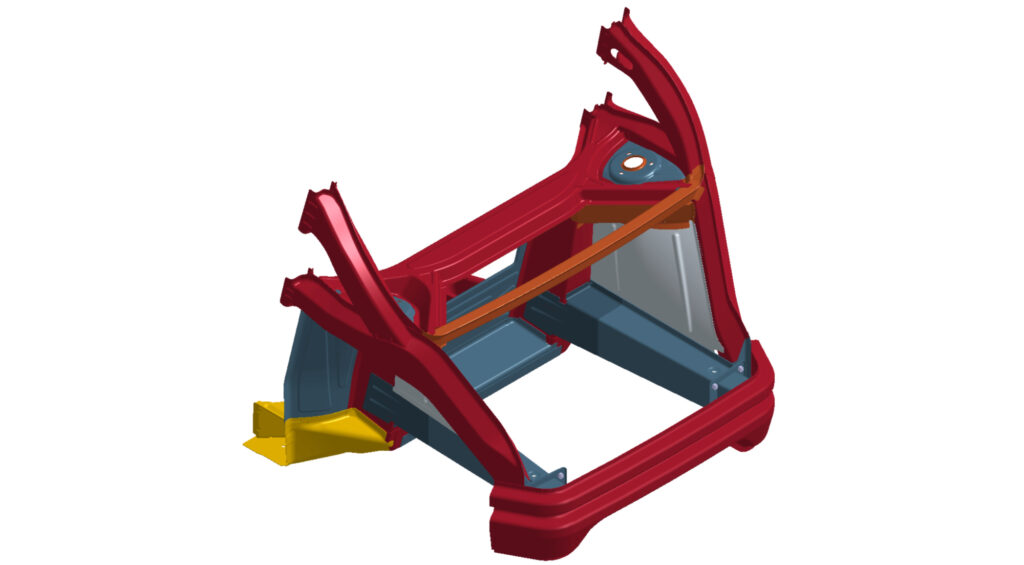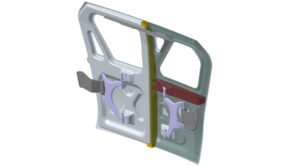
MaaS AV body structure concept touts better passenger safety, lighter battery carrier frame
By onMarket Trends
The results of a global steel industry initiative aimed at developing the world’s first fully autonomous, electric vehicle (EV) body structure concept for ride-sharing were unveiled last week by WorldAutoSteel.
The project, called Steel E-Motive, is the culmination of a three-year research program led by WorldAutoSteel and in partnership with global engineering firm, Ricardo.
A 1/3-scale, body-in-white model of the Steel E-Motive vehicle structure debuted at the 2023 Great Designs in Steel Conference (GDIS) on May 24 in Detroit.
WorldAutoSteel and Ricardo say Steel E-Motive will create a big step forward in making autonomous ride-sharing and ride-hailing vehicles an affordable, sustainable, and zero emissions reality – enabled by Advanced High-Strength Steel (AHSS) products and technologies.
“The results are safe, comfortable, and affordable body structures that support automakers in the continued development of Mobility as a Service (MaaS) ride-sharing models,” WorldAutoSteel said.
Key program results, according to WorldAutoSteel, include:
-
- Potential lifecycle CO2 emissions reduction of around 86%;
- A 25% mass reduction compared to a 374 kg reference vehicle;
- AHSS body structure and closures purpose-fit for MaaS EVs;
- AHSS extended passenger protection zone provides greater intrusion protection for rear-facing passengers;
- Engineered to meet global high speed crash regulations that can achieve the Insurance Institute for Highway Safety (IIHS) “good” rating, including a short front crash zone structure and a small offset crash glance beam to minimize cabin intrusion and lower crash pulse;
- Seven AHSS innovations that provide safe, efficient and economical vehicle architectures; and
- A 37% lighter battery carrier frame that eliminates the conventional battery case and uses the floor as the top cover, plus an AHSS triple-skinned bottom cover that seals the battery and provides protection from road debris and jacking errors. The design can be used in battery EV design development.
“The objective of Steel E-Motive was twofold: one, as an industry, to create a solution that supports a sustainable, safe, and affordable future for urban mobility; and two, to showcase the role modern steel can play in making that future a reality,” said Cees ten Broek, WorldAutoSteel director.
“This project represents an important step forward for autonomous ride-sharing and zero-emission transport, and truly demonstrates how working together as an industry yields important results.”
Two virtual concepts have been designed for model years 2030-2035 deployment.
The SEM1, a four-passenger concept car for urban commuting, has a single-speed front electric drive with a compact design and vehicle footprint that is comparable to the European B/C segment size. It’s a mixture of stamped, roll formed, roll stamped, tailor welded blanks (TWB), press hardened steel, and hydroformed parts that have been spotwelded, laser welded, or structurally adhered.
The second concept, SEM2, is a six-passenger extra-urban commuter. Both vehicles are designed for SAE Level 5 autonomy with no steering or pedal box, meaning the vehicle is fully in control of all driving tasks.
Other specifications include:
-
- Compact size with short front and rear overhangs;
- Average tensile strength for the body structure of 1259 MPa;
- Low step-in height and scissor doors encasing B-pillar create wide door access for ease of ingress and egress;
- Flexible, open interior designed for rear-facing front occupants;
- Designed non-specific battery use and maximum battery volume;
- Adaptable to carry cargo in off-peak hours;
- Four-wheel steering for tight turning circles; and
- High volume production of more than 250,000.
“Our experts are working with global OEMs and Tier 1 suppliers to develop solutions for the future of clean and sustainable mobility,” said Ricardo Chief Engineer Neil McGregor.
“The impressive performance, safety, and lifecycle results of this program are validation that steel is infinitely tunable, offering engineering and design flexibility that enables efficient and effective solutions. It has the potential to shape not only the future of Mobility as a Service, but how we design and utilize shared passenger transport in urban environments and city landscapes.”
George Coates, WorldAutoSteel technical director, added, “Steel E-Motive serves as a foundational blueprint for a wide range of applications. Startups and vehicle manufacturers can benefit from fully engineered concepts that can significantly reduce both cost and time to market.
“It also provides demonstrated results that meet or exceed stringent global crashworthiness standards enabled by the use of high-strength steels — applicable on BEVs in the near-term or future. “From a cost perspective, the study highlights important benefits as well. We
engineered this program to be affordable for production and to achieve the lowest total lifecycle emissions, putting us squarely on the path towards net zero. Using steel supports the use of existing manufacturing infrastructures, which helps to provide low ownership costs, critical for broad adoption.”
Steel E-Motive results, data, and CAD models are given freely to automotive manufacturers and others around the world to study and apply its learnings and innovations to produce a new generation of efficient, economic, and sustainable vehicles.
Images
Featured image: An artist rendering of the SEM1.
SEM1 short front crash zone structure.
SEM1 battery frame and case.
SEM1 AHSS extended passenger protection zone.
SEM1 B-pillar.
All images provided by WorldAutoSteel




